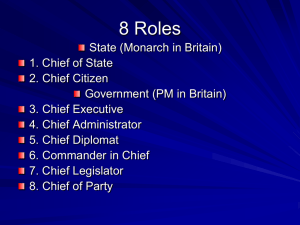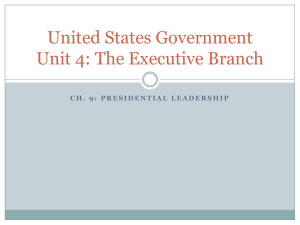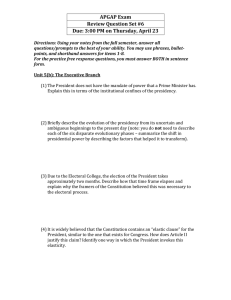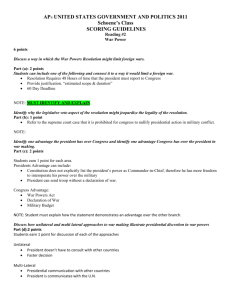The Characteristics and Evolution of the U.S. Presidency
advertisement
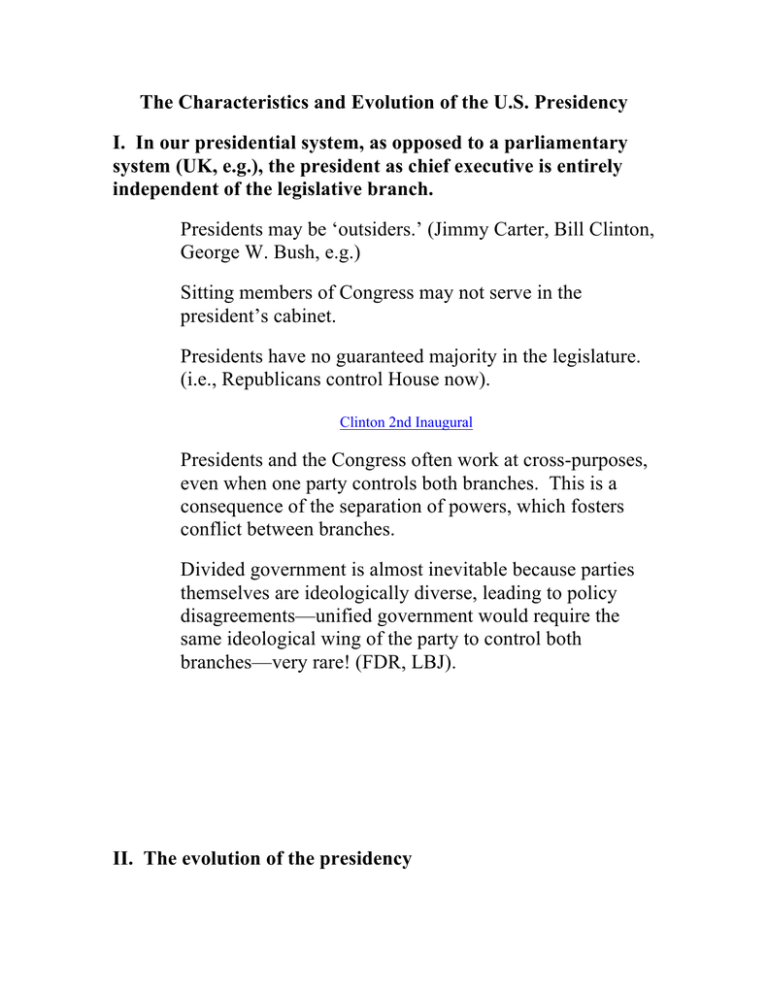
The Characteristics and Evolution of the U.S. Presidency I. In our presidential system, as opposed to a parliamentary system (UK, e.g.), the president as chief executive is entirely independent of the legislative branch. Presidents may be ‘outsiders.’ (Jimmy Carter, Bill Clinton, George W. Bush, e.g.) Sitting members of Congress may not serve in the president’s cabinet. Presidents have no guaranteed majority in the legislature. (i.e., Republicans control House now). Clinton 2nd Inaugural Presidents and the Congress often work at cross-purposes, even when one party controls both branches. This is a consequence of the separation of powers, which fosters conflict between branches. Divided government is almost inevitable because parties themselves are ideologically diverse, leading to policy disagreements—unified government would require the same ideological wing of the party to control both branches—very rare! (FDR, LBJ). II. The evolution of the presidency A. Concerns of the Framers—wanted a relatively weak executive Fear of military power of president Fear of presidential bribery to ensure reelection (electoral college) Fear of presidential corruption by Senate, because of shared treaty-making power Principle concern was to balance power of executive and legislative branches B. Electoral College Each state to choose own method of selecting electors Electors would meet in their own capital to choose president and vice president If no majority, House of Representatives would decide the election. Electoral College ultimately worked differently than expected, because Framers did not anticipate the role of political parties. Khan Academy Electoral College (11 min) Presidential Term of Office George Washington set two-term precedent Twenty-second Amendment (1951) limited president to two terms or ten years by Constitution (FDR) Powers of the President Formal powers found in Article II of the Constitution Some powers can be unilaterally exercised by the president, while others require formal legislative approval Potential for power found in ambiguous clauses of the Constitution—e.g., “commander in chief”, “take care that laws be faithfully executed.” Greatest source of power lies in politics and public opinion—“chief agenda setter,” “head of party” III. Presidents have exercised differing levels of power First presidents minimized fear of the presidency because of the overall lack of government activism during this era. Jackson (1828-1836) first “active” president—believed in strong and independent presidency. Used veto frequently, for constitutional and policy reasons. Following Jackson, Congress reemerged as the dominant branch, for the next century. Only Lincoln expanded presidential power—asserted ‘implied powers’ and authority as Commander-in-Chief. Justified actions by emergency created by Civil War. Following Lincoln, Congress again became dominant power until FDR (exceptions: TR and Wilson). Even today, the popular conception of the president as the center of government contradicts the reality—Congress is often the policy leader— President Obama has struggled to pass much of his agenda without having the Democrats in control of Congress. Presidential power has been reduced since Nixon—Bush tried to restore executive power, with the encouragement of Cheney. (“Unitary Executive Theory, Signing statements, e.g.—see Charlie Savage article) The Office of the President I. The president has several different groups working under him: The White House staff (advisors, chief of staff, spokesman, etc.); the Executive Office of the President (EOP)— appointments must receive Senate approval (unlike the White House staff). EOP includes: Office of Management and Budget, Director of National Intelligence, Council of Economic Advisers, Office of Personnel Management. The Cabinet (chief executives—“secretaries”—of the executive branch departments) Independent agencies, commissions, and judgeships II. Who gets appointed? President knows few appointees personally Most appointees to the cabinet and sub-cabinet have federal experience (“In-and-outers”—alternate federal government and private sector jobs) Need to consider groups, regions, and organizations when making appointments Rivalry often develops between department heads (who represent expert knowledge) and White House staff (who are extensions of presidential priorities). III. The power to persuade There are three main audiences for the president’s persuasive powers: fellow politicians in Washington, D.C.; party activists outside Washington; the public. Presidents try to transform popularity into congressional support for their programs—despite the fact that Congressional elections are relatively insulated from presidential elections. To avoid the risks of opposing a popular president, Congress will pass more of that individual’s legislative proposals. IV. The power to say ‘no’ 1. Veto/veto threat 2. Executive privilege—confidential communications between president and advisors need not be disclosed. Justification? Separation of powers, need for candid advice. But—Nixon v. U.S. (1973) rejected claim for absolute executive privilege. Recently, Eric Holder cited executive privilege in not turning over certain documents to a Congressional panel investigating “Fast and Furious” scandal. 3. Impoundment of funds Definition? Presidential refusal to spend funds appropriated by Congress Nixon’s impoundments prompted the Budget Reform Act of 1974, limiting presidential impoundment power. V. The president’s program A. Putting together a program 1. Resources in putting together a program include interest groups, aides and campaign advisors, federal departments and agencies, and specialists. B. Constraints on a president’s program 1. Public and congressional reactions 2. Limited time and attention span of president 3. Unexpected crises 4. Programs can be changed only marginally because most resources are already committed. 5. Presidents typically must focus on the economy and foreign affairs. Presidential Transition I. Only 14 of the 43 presidents have served two terms. II. The Vice-President does not automatically become the ‘heir apparent.’ While eight v-p’s have succeeded to office upon the death of the president, only five vice-presidents have won the presidency in an election (without having entered office upon the death of the president). Vice-president’s responsibilities vary greatly from president to president. Officially, vice president presides over the Senate and votes in case of a tie. Other duties are largely assigned by the president. What if the president falls ill? (Garfield, Wilson, Eisenhower, Reagan, eg). Each situation is handled differently. If vice president steps up, who becomes vice president? 25th Amendment (1967) establishes procedures: allows vice president to serve as acting president if the president is ill (determined by president, v-p and cabinet, or 2/3 vote in Congress). III. Impeachment Indictment and prosecution by the House, conviction (or acquittal) by the Senate. Andrew Johnson and Bill Clinton only two—neither was convicted. Richard Nixon avoided by resigning. Some fear impeachment will increasingly be considered by Congress for political reasons (both Clinton and Johnson, e.g.) Constitution is vague: “High crimes and misdemeanors.” IV. How powerful is the president? More constrained than many think. Complexity of issues, power of special interest groups, and intense media scrutiny has limited presidential power. Bush obviously extended presidential power via signing statements and actions taken as “CIC”. Obama has retained significant executive authority thanks in part to Bush’s precedents. See controversy surrounding NSA/ “meta-data”


